RENAULT KANGOO 2012 X61 / 2.G Owner's Manual
Manufacturer: RENAULT, Model Year: 2012, Model line: KANGOO, Model: RENAULT KANGOO 2012 X61 / 2.GPages: 237, PDF Size: 8.62 MB
Page 21 of 237

JauneNoirNoir texte
1.15
ENG_UD29319_4
Appuis-tête avant (X61 - F61 - K61 - Renault)
ENG_NU_813-11_FK61_Renault_1
To remove the headrest
Raise it to its highest position. Press
button 4 and lift the headrest to release
it.
Note: when the headrest is removed,
take care not to change the positions
of the rods.
To refit the headrest
If the setting of the rods has been al -
tered, pull them fully upwards. Take
care to ensure they are clean and cor-
rectly aligned and, if there are any prob-
lems, check that the notches are facing
forwards.
Insert the headrest rods into the holes
(tilt the seatback backwards if neces -
sary).
Lower the headrest until it locks, press
button 3 and lower the headrest as far
as possible.
FRONT HeADReSTS (2/3)
Headrest B
To raise the headrest
Pull it upwards to the required height.
To lower the headrest
Press button 3 and guide the headrest
down to the desired height.
The headrest is an impor -
tant safety component:
ensure that it is in place
and in the correct position.
The distance between your head
and the headrest should be as small
as possible. The top of your head
should be in line with the top of the
headrest.
3
B
4
Page 22 of 237
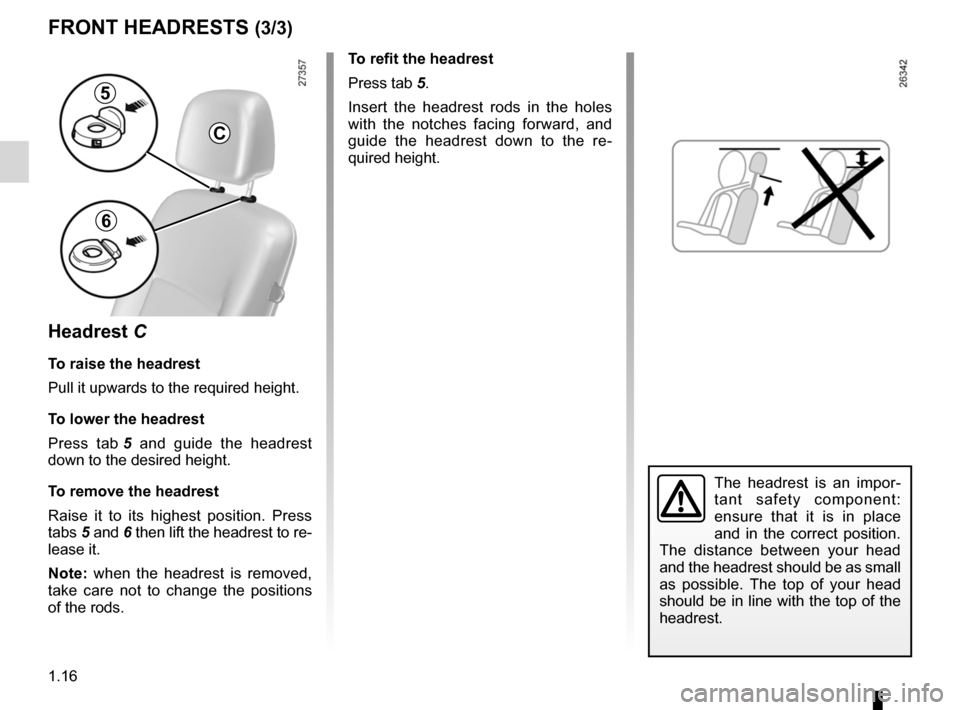
1.16
ENG_UD29319_4
Appuis-tête avant (X61 - F61 - K61 - Renault)
ENG_NU_813-11_FK61_Renault_1
FRONT HeADReSTS (3/3)
Headrest C
To raise the headrest
Pull it upwards to the required height.
To lower the headrest
Press tab 5 and guide the headrest
down to the desired height.
To remove the headrest
Raise it to its highest position. Press
tabs 5 and 6 then lift the headrest to re-
lease it.
Note: when the headrest is removed,
take care not to change the positions
of the rods.
To refit the headrest
Press tab 5.
Insert the headrest rods in the holes
with the notches facing forward, and
guide the headrest down to the re -
quired height.
The headrest is an impor -
tant safety component:
ensure that it is in place
and in the correct position.
The distance between your head
and the headrest should be as small
as possible. The top of your head
should be in line with the top of the
headrest.
5
6
C
Page 23 of 237

headrest................................................ (up to the end of the DU)
1.17
ENG_UD21411_3
Appuis-tête arrière (X61 - F61 - K61 - Renault)
ENG_NU_813-11_FK61_Renault_1
The headrest is a safety
component; check that it is
fitted and in the correct po-
sition.
Storage position 2Pull it towards you and lower it com -
pletely.
When the headrest is fully lowered, it
is in the storage position: do not use
this position when someone is sitting in
the rear seats.To raise itSlide it to the required height.
To lower itPull it towards you and slide it to the re-
quired height.
To remove it
Raise the headrest then press tabs 1 to
release it.
To refit itPress tab 1 and insert the rods into the
holes, with the notches facing forwards.
ReAR HeADReSTS
12
Child’s convertible headrest
If fitted to the vehicle, the child head -
rest and booster cushion can only be
installed on the rear side seats.
For fitting and use, refer to the equip -
ment instructions.
Page 24 of 237
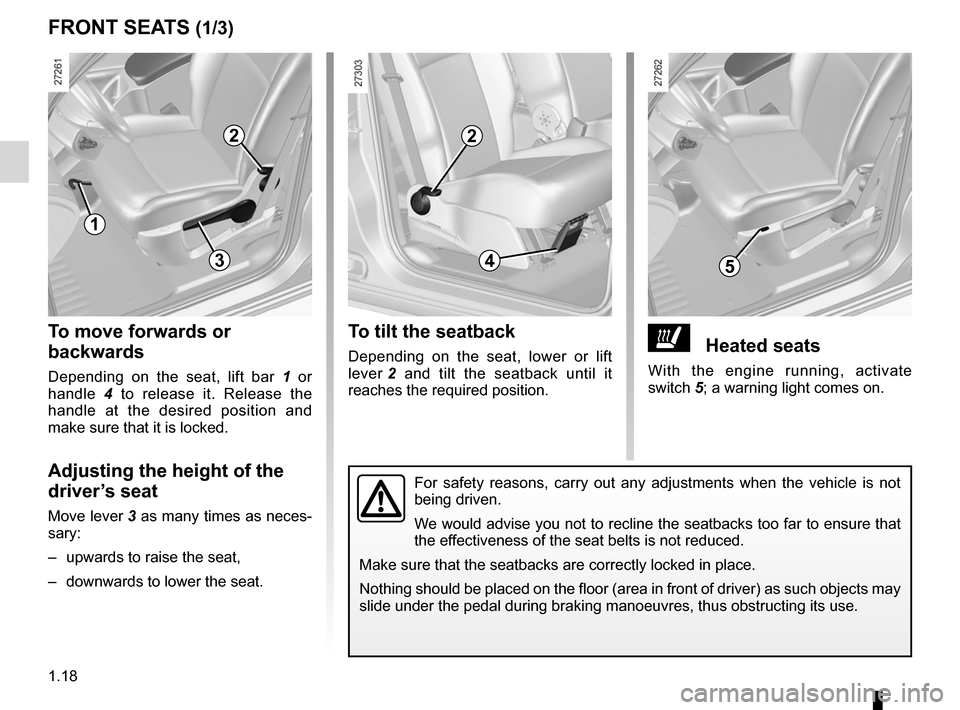
front seatsadjustment ...................................... (up to the end of the DU)
heated seats ......................................... (up to the end of the DU)
front seat adjustment ............................(up to the end of the DU)
1.18
ENG_UD21409_6
Sièges avant (X61 - F61 - K61 - Renault)
ENG_NU_813-11_FK61_Renault_1
Jaune NoirNoir texte
Front seats
ðHeated seats
With the engine running, activate
switch 5; a warning light comes on.
To tilt the seatback
Depending on the seat, lower or lift
lever 2 and tilt the seatback until it
reaches the required position.
To move forwards or
backwards
Depending on the seat, lift bar 1 or
handle 4 to release it. Release the
handle at the desired position and
make sure that it is locked.
Adjusting the height of the
driver’s seat
Move lever 3 as many times as neces-
sary:
– upwards to raise the seat,
– downwards to lower the seat.
FRONT SeATS (1/3)
1
2
534
2
For safety reasons, carry out any adjustments when the vehicle is not
being driven.
We would advise you not to recline the seatbacks too far to ensure that
the effectiveness of the seat belts is not reduced.
Make sure that the seatbacks are correctly locked in place.
Nothing should be placed on the floor (area in front of driver) as such objects may
slide under the pedal during braking manoeuvres, thus obstructing its use.
Page 25 of 237
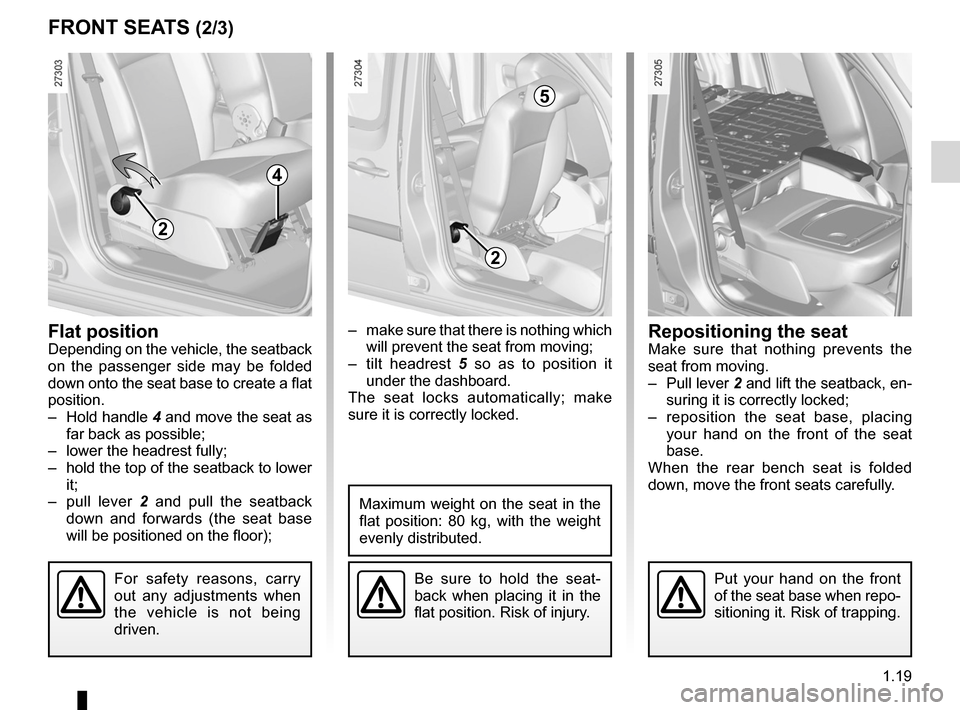
JauneNoirNoir texte
1.19
ENG_UD21409_6
Sièges avant (X61 - F61 - K61 - Renault)
ENG_NU_813-11_FK61_Renault_1
– make sure that there is nothing which
will prevent the seat from moving;
– tilt headrest 5 so as to position it
under the dashboard.
The seat locks automatically; make
sure it is correctly locked.Flat positionDepending on the vehicle, the seatback
on the passenger side may be folded
down onto the seat base to create a flat
position.
– Hold handle 4 and move the seat as
far back as possible;
– lower the headrest fully;
– hold the top of the seatback to lower
it;
– pull lever 2 and pull the seatback
down and forwards (the seat base
will be positioned on the floor);
Be sure to hold the seat -
back when placing it in the
flat position. Risk of injury.
Maximum weight on the seat in the
flat position: 80 kg, with the weight
evenly distributed.
FRONT SeATS (2/3)
4
2
2
5
For safety reasons, carry
out any adjustments when
the vehicle is not being
driven.Put your hand on the front
of the seat base when repo-
sitioning it. Risk of trapping.
Repositioning the seatMake sure that nothing prevents the
seat from moving.
– Pull lever 2 and lift the seatback, en-
suring it is correctly locked;
– reposition the seat base, placing
your hand on the front of the seat
base.
When the rear bench seat is folded
down, move the front seats carefully.
Page 26 of 237
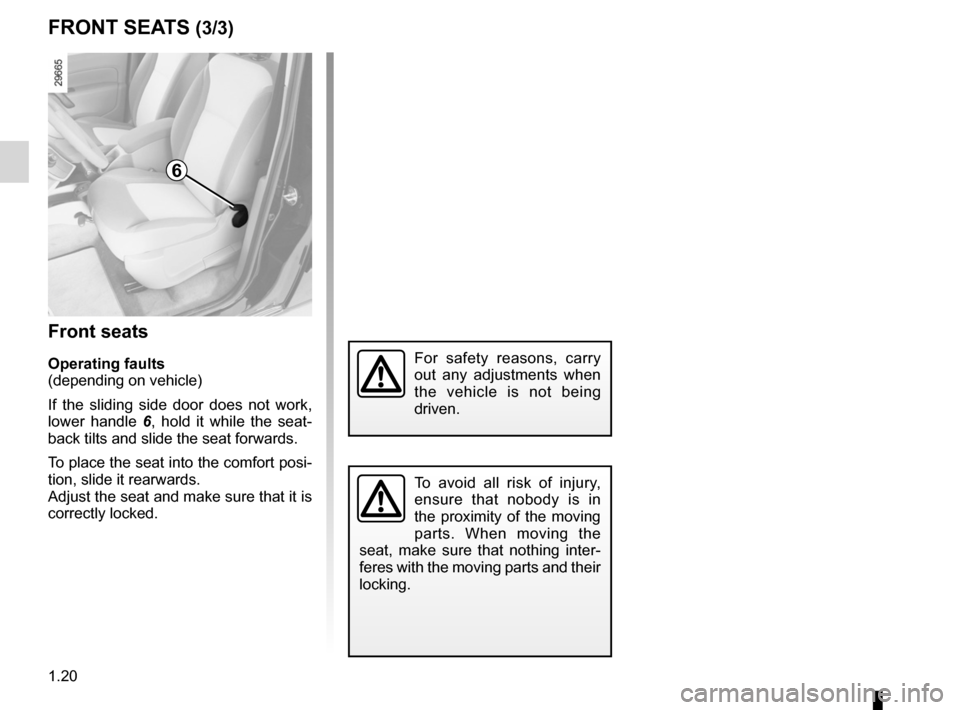
1.20
ENG_UD21409_6
Sièges avant (X61 - F61 - K61 - Renault)
ENG_NU_813-11_FK61_Renault_1
FRONT SeATS (3/3)
Front seats
Operating faults
(depending on vehicle)
If the sliding side door does not work,
lower handle 6 , hold it while the seat -
back tilts and slide the seat forwards.
To place the seat into the comfort posi-
tion, slide it rearwards.
Adjust the seat and make sure that it is
correctly locked.
To avoid all risk of injury,
ensure that nobody is in
the proximity of the moving
parts. When moving the
seat, make sure that nothing inter -
feres with the moving parts and their
locking.
For safety reasons, carry
out any adjustments when
the vehicle is not being
driven.
6
Page 27 of 237
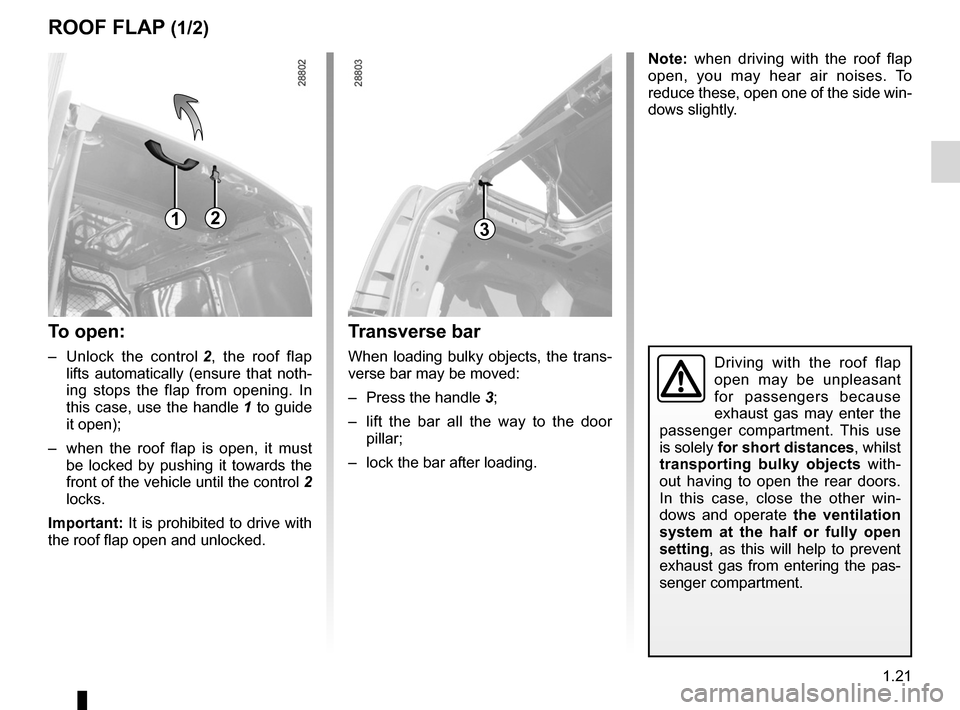
1.21
ENG_UD21407_3
Trappe de pavillon (X61 - F61 - K61 - Renault)
ENG_NU_813-11_FK61_Renault_1
Roof flap
ROOF FLAp (1/2)
Driving with the roof flap
open may be unpleasant
for passengers because
exhaust gas may enter the
passenger compartment. This use
is solely for short distances, whilst
transporting bulky objects with-
out having to open the rear doors.
In this case, close the other win -
dows and operate the ventilation
system at the half or fully open
setting, as this will help to prevent
exhaust gas from entering the pas-
senger compartment.
123
Transverse bar
When loading bulky objects, the trans-
verse bar may be moved:
– Press the handle 3;
– lift the bar all the way to the door
pillar;
– lock the bar after loading.
To open:
– Unlock the control 2 , the roof flap
lifts automatically (ensure that noth-
ing stops the flap from opening. In
this case, use the handle 1 to guide
it open);
– when the roof flap is open, it must
be locked by pushing it towards the
front of the vehicle until the control 2
locks.
Important: It is prohibited to drive with
the roof flap open and unlocked. Note:
when driving with the roof flap
open, you may hear air noises. To
reduce these, open one of the side win-
dows slightly.
Page 28 of 237
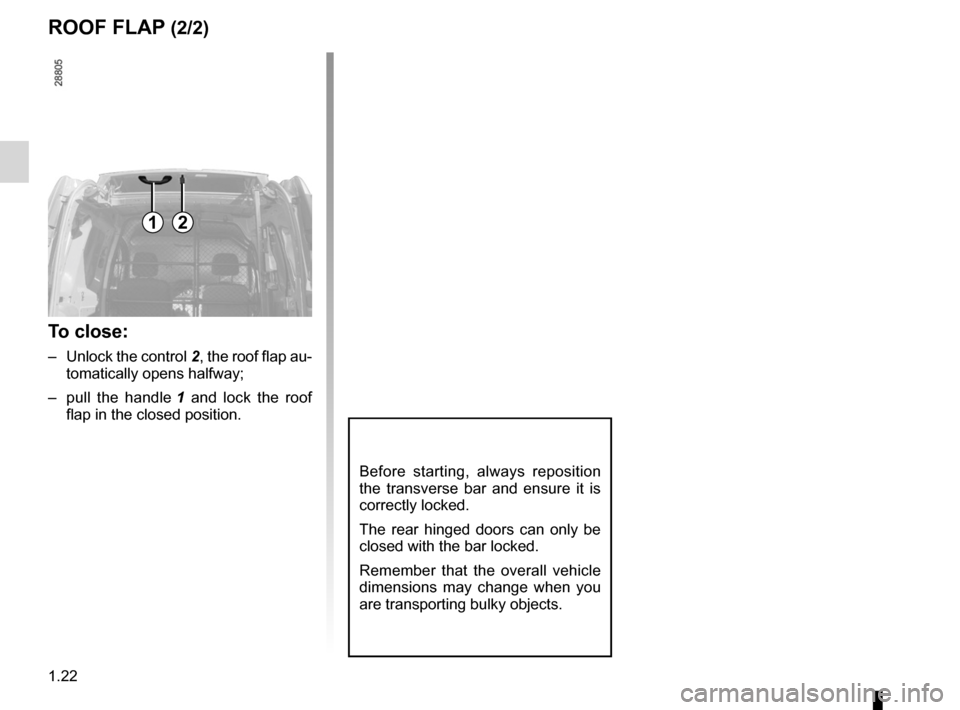
1.22
ENG_UD21407_3
Trappe de pavillon (X61 - F61 - K61 - Renault)
ENG_NU_813-11_FK61_Renault_1
ROOF FLAp (2/2)
Before starting, always reposition
the transverse bar and ensure it is
correctly locked.
The rear hinged doors can only be
closed with the bar locked.
Remember that the overall vehicle
dimensions may change when you
are transporting bulky objects.
12
To close:
– Unlock the control 2, the roof flap au-
tomatically opens halfway;
– pull the handle 1 and lock the roof
flap in the closed position.
Page 29 of 237
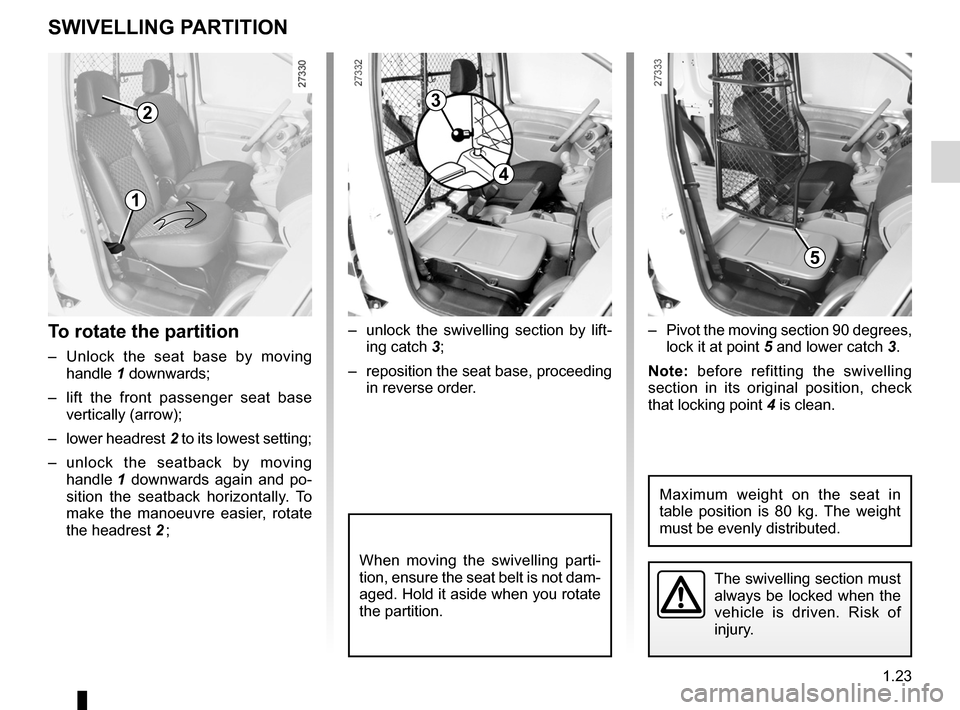
partition ................................................. (up to the end of the DU)
1.23
ENG_UD21408_2
Cloison de séparation (X61 - F61 - K61 - Renault)
ENG_NU_813-11_FK61_Renault_1
To rotate the partition
– Unlock the seat base by moving
handle 1 downwards;
– lift the front passenger seat base
vertically (arrow);
– lower headrest 2 to its lowest setting;
– unlock the seatback by moving
handle 1 downwards again and po -
sition the seatback horizontally. To
make the manoeuvre easier, rotate
the headrest 2 ; –
Pivot the moving section 90 degrees,
lock it at point 5 and lower catch 3.
Note: before refitting the swivelling
section in its original position, check
that locking point 4 is clean.
–
unlock the swivelling section by lift -
ing catch 3;
– reposition the seat base, proceeding
in reverse order.
Swivelling partition
The swivelling section must
always be locked when the
vehicle is driven. Risk of
injury.
SWIveLLING p ARTITION
When moving the swivelling parti -
tion, ensure the seat belt is not dam-
aged. Hold it aside when you rotate
the partition.
1
23
4
5
Maximum weight on the seat in
table position is 80 kg. The weight
must be evenly distributed.
Page 30 of 237
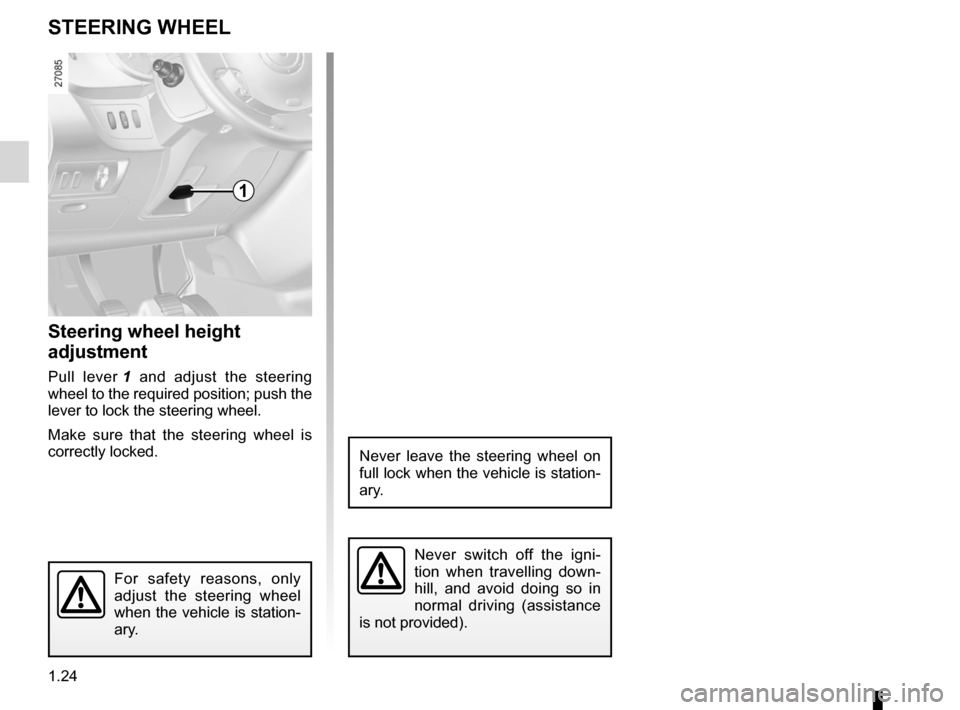
steering wheeladjustment ...................................... (up to the end of the DU)
1.24
ENG_UD4418_1
Volant de direction (X61 - F61 - K61 - Renault)
ENG_NU_813-11_FK61_Renault_1
Volant de direction
STeeRING WHeeL
Steering wheel height
adjustment
Pull lever 1 and adjust the steering
wheel to the required position; push the
lever to lock the steering wheel.
Make sure that the steering wheel is
correctly locked.
For safety reasons, only
adjust the steering wheel
when the vehicle is station-
ary.
Never leave the steering wheel on
full lock when the vehicle is station-
ary.
1
Never switch off the igni -
tion when travelling down -
hill, and avoid doing so in
normal driving (assistance
is not provided).